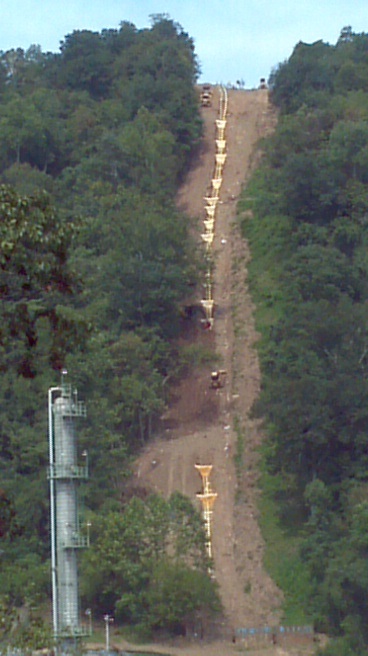November 2011, Vol. 238 No. 11
TechNotes
Pipeline Job On 58-degree Slope Uses Geotechnical Polyurethane Trench Breakers And Pillows

A recent West Virginia pipeline construction job on a 58-degree slope used geotechnical polyurethane pipe pillows and trench breakers made by a U.S. company, NCFI Polyurethanes.
The job was at Dominion Resource’s extraction/fractionation plant in Pine Grove, WV and offered some “pretty hairy” challenges according to observers.
First, the pipeline was laid on a 58-degree hillside. That meant trucks, excavators, and other equipment had to be winched up the slope and held in place by cables attached to heavy equipment. Second, it was the rainy season, so erosion of the freshly turned earth was a major concern.
Chad Corbin’s company – All Seasons Foam and Coatings Services, Sanger, TX – was chosen to create pipeline pillows and trench breakers for the project.

Said Corbin, “We took one look at it and – when most companies might have thrown up their hands or declined the job – we felt right at home. They laid 1,400 feet of pipe on a 58-degree slope. That’s steep. We had to cable the excavator and our spray rig, winch it up the hill, and secure it to two or three dozers while we worked.”
Geotechnical Polyurethane Foam
Corbin said his company selected the TerraThane geotechnical polyurethane foam system by NCFI to meet the challenge. Corbin observed, “TerraThane is a great product. Polyurethane foam is far superior to sand breakers. Water eats through the sand breakers and the sand escapes and erodes over time. Polyurethane foam breakers bond with the earth, and water doesn’t have an effect on them. They’re easier to apply and they last.”

Corbin said his company uses NCFI foam because, “unlike other foams we’ve tried and seen used, TerraThane doesn’t char inside, doesn’t smoke when you spray it, or get crusty inside. It’s the highest quality product on the market.” He added, “Their (NCFI’s) technical support people are dedicated to our success. They are always on call when we’re on a job.”
Pat Burchett – TerraThane product manager for NCFI – says the West Virginia job is an excellent example of why foam systems are replacing sand breakers. Burchett said, “Less labor is required, there is less chance of injury as compared to handling sandbags, allowing for quicker construction and providing time savings. Our system is formulated for low exothermic heat and tested per ASTM test procedures for strength values and dimensional stability. It’s a two- component polyurethane foam designed for great lift thicknesses without scorching or splitting during field applications.”





Comments